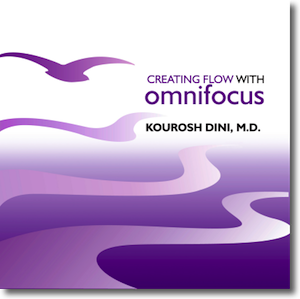In review: Creating Flow with OmniFocus
 I love to read books, but I rarely read books on software. If I do, I normally use them as a reference guide, picking and choosing specific parts.
I love to read books, but I rarely read books on software. If I do, I normally use them as a reference guide, picking and choosing specific parts.
Kourosh Dini’s Creating Flow with OmniFocus ($29.95) was a different story. When Kourosh offered me a review copy a few weeks ago, I agreed to take a look. I wasn't planning to read it cover to cover. But I did.
Granted, the timing was excellent for me. I still consider myself someone who is learning OmniFocus.1 Reading Creating Flow with OmniFocus turned out to be well worth my time.
The book is for you if
- You like to read books (not everyone does).
- You’ve just started using OmniFocus.
- You’ve been using OmniFocus for a while but feel somewhat overwhelmed.
- You already have some foundation in GTD and want to see it in an OmniFocus context.
The book isn’t for you if
- You aren’t a concept learner. Don’t come to the book expecting to memorize mechanics that you can mindlessly apply.
- You’re looking for in-depth information on the mobile versions of OmniFocus. While the iPhone and iPad versions are covered, the primary focus is the desktop version.
Things I really like about the book
- Kourosh takes full advantage of the ePub format providing crisp images, screen shots, and also hyperlinks to external resources.2
- Kourosh leverages his mixed background in both creative work (music) and science (psychiatry) to provide an interesting and broad perspective on applying OmniFocus to various lifestyles.
- Reviewing seems to be the core focus of the book. Considering that review is the most artistic, important, and often neglected aspect of GTD, in my opinion, this is a good thing. Kourosh really emphasizes the review aspect of GTD and shows several examples of highly practical custom reviews.
- There are many great little practical tips in the book. A few of my favorites were project tickler tasks (i.e. the “start task”), how to use a “waiting for” context effectively, and how to hyperlink to perspectives.
- Kourosh covers how to create project templates and explains why you might want to.
- Toward the end of the book, Kourosh goes into more abstract concepts. For example, he discusses his views on attention (e.g. layers of attention and how to repair “injured” attention), prioritization at different levels, and defining success.
And speaking of success, I really like Kourosh’s interpretation of it:
… success occurs when one can play in the world such that the world feeds back and supports that person in play.
I think this is also a good reminder (maybe even shocking for some) that the purpose of any GTD-based system should be to increase the fulfillment and enjoyment of life, not to get everything done in a machine-like manner.
I'm using OmniFocus because I want to get better at leveraging the strengths I already possess as an individual, and I want to focus on the things I enjoy pursuing the most. If you're searching for the same OmniFocus-aided nirvana, reading Creating Flow with OmniFocus will probably be a good use of your time. It was mine.
